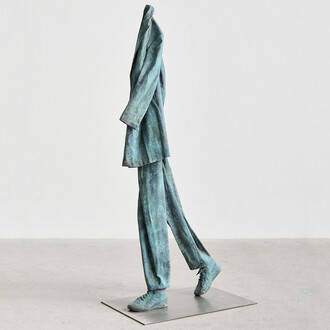Baert Gallery is pleased to present an exhibition of new works by José Manuel Ciria.
Born in 1960, Ciria is a central figure in the panorama of Spanish painting of the last three decades. In the early nineties, after his early period involved with expressionistic figuration, Ciria honed his defining abstract poetic program—structured in series—as the dialogue between the uncontrolled flow of the stain and the rigor of geometry, and which constituted a critical redefinition of the two fundamental tools of abstract aesthetics of the 20th century. The artist's interest in the diversity of iconographic registers, as well as his tireless experimentation in the terrain of materials and supports, would soon be added to that initial program. Out of the combination of all possibilities, and fed by a strong conceptual model, Ciria created numerous works in series during this period whose main thematic axes were time and memory.
The new period Ciria initiated in New York in late 2005 was a unique point of departure in his practice that signaled a process of cooling down in the painting process using the recovery of line as a compositional armature, and subsequently stabilizing an ambiguous iconography at a midway point between figuration and abstraction. During this time the artist recovered and intensified the two extremes of his abstract vocabulary; the stain became more free, intense, and dramatic, while the ground of these new paintings gave way to a greater accentuation of the constructive rigor of geometry.
In 2013, after a brief stay in Berlin, Ciria moved to London and began a new series entitled The London Boxes that represents the most recent level of his specific line of investigation begun in 2005. It was with this body of work that the artist began to understand the overall composition of a painting as a set of conscious decisions; form modulated by drawing surfaced as a key theme. During this time, he created figurative works (within the broad margins permitted in contemporary figuration) alongside totally non-referential pieces and other compositions difficult to place in either camp.
In 2015, Ciria returned to Madrid. Although he had charted out the basic outline of a new series during his last months in London, it was in Madrid, under the pressure to produce pieces for the present exhibition, that he developed yet another body of work representing a new stage in his painterly discourse. In this series entitled Procedures, paintings have not been structured by means of any particular single method, but rather through the implementation of a broad combination of options available to him in terms of technique and iconography. The artist has exploited an expansive inventory of techniques that covers virtually every possibility of applying paint to a supporting surface.
The virtue of the Procedures series lies in the diverse strategies of visual representation the artist has employed to weave a joyous and exultant new narrative free of the constraining geometry that previously governed his work. There is greater emphasis on emotion than thought, intuition rather than theoretical questioning, and the expansion of the image rather than the compositional framework. Here Ciria has taken a rhizomatic approach, exploiting the possibilities of variation, expansion, conquest, capture, and offshoots. The visual result is a map that offers multiple non-hierarchical entrance and exit points, and multiple lines of escape that defy any system of central authority and allows every single element to be linked to all the others.
Throughout his professional career, Ciria has gained a wide international recognition through solo and group exhibitions at prestigious institutions, among which include the Herzliya Contemporary Art Museum in Tel Aviv, Israel (2002), the Tretyakov State Gallery in Moscow, Russia (2004), the Polish National Museum of Poland, Warsaw (2004), the Museo de Arte Abstracto Manuel Felguérez in Zacatecas Mexico (2005), the PasquArt Kunsthalle Art Center Museum in Bern, Switzerland (2005), the Museo de Arte Contemporáneo Ateneo de Yucatán in Mérida, Mexico (2006), the Museo Nacional de Bellas Artes de Buenos Aires, Argentina (2007), the Museo de Arte Contemporáneo, Santiago de Chile (2009), the Instituto Valenciano de Arte Moderno (IVAM) (2012), the Heritage Museum (MUPAM), Malaga (2012), the National Museum of Contemporary Art (MINAC), Bucharest (2012) and the Museum of Modern Art (MAMBA), Buenos Aires, Argentina (2013). His work is in numerous institutional and private collections including the National Museum Art Center Reina Sofia (MNCARS), Spain ; the Valencian Institute of Modern Art (IVAM), Spain ; the Municipal Museum of Contemporary Art, Spain and The Albertina Museum, Austria.
















